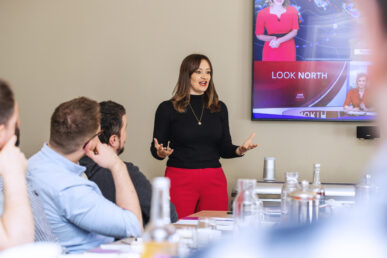Whether you prefer PowerPoint, Keynote, or one of the newer kids on the block like Prezi or Menti, slides remain a crucial part of business communication more than 30 years since the original PowerPoint was first created.
When I joined the BBC Weather Team almost 20 years ago, I discovered our own version of slides – the TV weather graphics. Back then, weather symbols were added by clicking the mouse on the appropriate spot on the map – a digital advance on the nostalgic magnetic symbols introduced in the 1960s. Who could forget the unintended humour when they fell off the map or when Michael Fish apologised for the F in fog? Today we now use 3D real-time moving data. Whatever the technology, the aim has remained the same across the decades: Make the images as clear and concise as possible. Communicate the core message without words. They are a memorable visual aid in the truest sense.
What is a visual aid?
This is where many business presentations struggle when using a slide deck. The agenda slide starts off the meeting with a list of 20 bullet points; we then see another 50 slides loaded with words, diagrams, charts, data and maybe a bit of clip art to make it look ‘nice’. Without realising it, you may have lost the audience before you’ve even started because your slide deck is not a visual aid. It’s not visual because it’s a list of words, and while it may be an aid to you (as your script), it isn’t to your audience.
Dr John Medina spoke about this in his book ‘Brain Rules‘, where he looks at how we remember and recall important information through a series of fascinating stories. The take-home from the book is this: We retain more information where the slides are visual with strong, relevant images rather than a list of words. Simply put, it’s tough to read and absorb information while someone is speaking! You can try this for yourself. Get someone to talk to you while you’re reading something. You’ll find it challenging to listen and read at the same time. I know this is true because recently when I read an important e-mail, my husband started talking to me about moving the cars around on the drive.
‘Yes, yes,’ I said. ‘Sure’.
‘Let’s do it now,’ he said.
‘Do what?’ I said.
‘Move the car!’
I thought I was listening, but I hadn’t retained anything because I was reading the e-mail, which I then had to read again as that hadn’t sunk in either.
Consider your audience
What does any of this have to do with slides? Well, if you’re asking your audience to read or absorb complex slides while you’re talking, there’s a good chance key bits of your message will be lost. Imagine the frustration of spending days on a PowerPoint presentation only for people to go away without remembering the essential points. When I was a weather presenter for the BBC, we were encouraged to keep the graphics simple so the audience can absorb the visual basics of the weather story – I’m there to add detail. Our presenting aim is to bring value, meaning we don’t just say what you see on the screen. We create a compelling narrative by telling a story, making comparisons, explaining what the data means and always understanding the forecast before building our graphics. The narrative guides the visual aids, not the other way around.
So next time you have to prepare for a big presentation, create the story and then build your slides around it, or perhaps ask yourself if you even need to use slides? It can be much more engaging just to stand and talk. One of the most popular Ted Talks of all time is Sir Ken Robinson’s inspiring case for why schools kill creativity. He uses no slides at all.
One final point; remember YOU are the presentation, not the slides. Oh, and if you ever happen to find one of those original magnetic weather symbols, they’re highly collectable!




















